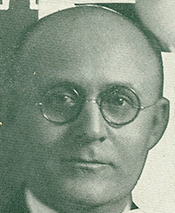George J. Schneider
George John Schneider (born October 30, 1877 in Grand Chute , Wisconsin , † March 12, 1939 in Toledo , Ohio ) was an American politician . Between 1923 and 1933 and again from 1935 to 1939 he represented the state of Wisconsin in the US House of Representatives .
Career
In his youth, George Schneider moved with his parents to Appleton , Wisconsin, where he attended public schools. Then he did an apprenticeship in papermaking. Between 1909 and 1927 he was Vice President of the International Brotherhood of Papermakers . Schneider was committed to workers' affairs and was a member of the Federation of Labor in Wisconsin from 1921 to 1928 . At that time he was a member of the Republican Party .
In the 1922 congressional election he was elected to the US House of Representatives in Washington, DC in the ninth constituency of Wisconsin , where he succeeded David G. Classon on March 4, 1923 . After four re-elections, he was initially able to complete five legislative terms in Congress by March 3, 1933 . These had been shaped by the events of the Great Depression since 1929 . Shortly before his departure from the US House of Representatives, the 20th amendment to the Constitution was passed, bringing forward the beginning of the presidential term and the legislative terms of the Congress from March to January.
Schneider was no longer nominated by his party for the elections in 1932 . This set up James A. Frear , who was then also elected Schneider's successor. As a result, this joined the Wisconsin Progressive Party . In 1934, Schneider was re-elected to the US House of Representatives as their candidate in the eighth district of Wisconsin. There he replaced the Democrat James F. Hughes on January 3, 1935 . After being re-elected in 1936, he was able to remain in Congress for two further terms until January 3, 1939. During this time, many of the federal government's New Deal laws were discussed and passed. In the 1938 election, George Schneider was defeated by Republican Joshua L. Johns .
After leaving the US House of Representatives, Schneider resumed his previous activities in the labor movement. However, he died on March 12, 1939, less than two months after the end of his last term in Congress, in Toledo and was buried in Appleton.
Web links
- George J. Schneider in the Biographical Directory of the United States Congress (English)
- George J. Schneider in the database of Find a Grave (English)
| personal data | |
|---|---|
| SURNAME | Schneider, George J. |
| ALTERNATIVE NAMES | Schneider, George John (full name) |
| BRIEF DESCRIPTION | American politician |
| DATE OF BIRTH | October 30, 1877 |
| PLACE OF BIRTH | Grand Chute , Wisconsin |
| DATE OF DEATH | March 12, 1939 |
| Place of death | Toledo , Ohio |

